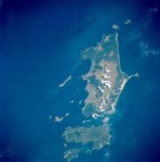
Flinders Island, Tasmania
Overview
Flinders Island is an island in Bass Strait
. It is 20 kilometres (12.4 mi) from Cape Portland
, the north-eastern tip of Tasmania
, Australia
and is the largest island in the Furneaux Group.
Flinders Island was first colonised at least 35,000 years ago, when people made their way across the then-land bridge which is now Bass Strait. A population remained until about 4500 years ago, until succumbing to thirst and hunger following an acute El Nino climate shift.
Some of the south-eastern islands in the Furneaux Group where first recorded in 1773 by British navigator Tobias Furneaux, commander of HMS Adventure, the support vessel with James Cook on Cook’s second voyage.
Bass Strait
Bass Strait is a sea strait separating Tasmania from the south of the Australian mainland, specifically the state of Victoria.-Extent:The International Hydrographic Organization defines the limits of the Bass Strait as follows:...
. It is 20 kilometres (12.4 mi) from Cape Portland
Cape Portland, Tasmania
Cape Portland is both a geographical feature and a location near the north eastern tip of Tasmania. It points west across Ringarooma Bay...
, the north-eastern tip of Tasmania
Tasmania
Tasmania is an Australian island and state. It is south of the continent, separated by Bass Strait. The state includes the island of Tasmania—the 26th largest island in the world—and the surrounding islands. The state has a population of 507,626 , of whom almost half reside in the greater Hobart...
, Australia
Australia
Australia , officially the Commonwealth of Australia, is a country in the Southern Hemisphere comprising the mainland of the Australian continent, the island of Tasmania, and numerous smaller islands in the Indian and Pacific Oceans. It is the world's sixth-largest country by total area...
and is the largest island in the Furneaux Group.
Flinders Island was first colonised at least 35,000 years ago, when people made their way across the then-land bridge which is now Bass Strait. A population remained until about 4500 years ago, until succumbing to thirst and hunger following an acute El Nino climate shift.
Some of the south-eastern islands in the Furneaux Group where first recorded in 1773 by British navigator Tobias Furneaux, commander of HMS Adventure, the support vessel with James Cook on Cook’s second voyage.
Unanswered Questions

